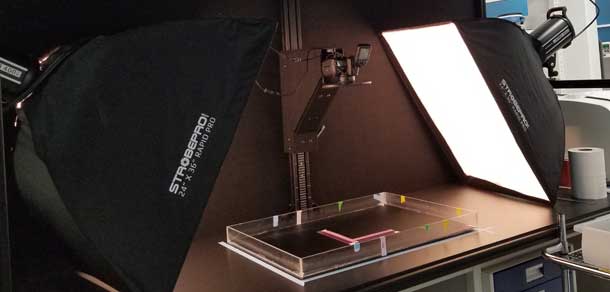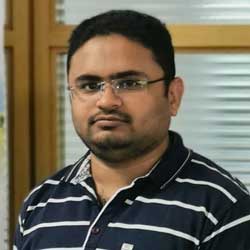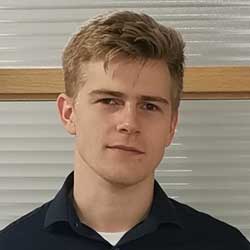GIFS Aims to Grow Food Better and Faster
Scientists estimate that the world’s population to 9.6 billion by 2050.
That’s a lot of hungry mouths to feed. In fact, to meet this demand, agricultural productivity will have to increase by 70 per cent over this time.
Karim Panjvani, Engineer-in-Training and Grant Tingstad, Engineer-in-Training
This is the challenge that led to the formation of the Global Institute for Food Security (GIFS), a partnership of Nutrien, the Government of Saskatchewan and the University of Saskatchewan. Founded in 2012, GIFS aims to perform research that will help deliver transformative innovation to agriculture in both the developed and the developing world.
Meeting this challenge requires a lot of brainpower. GIFS works with the best talent from around the world, including more than 60 researchers and affiliates from 21 countries.
Two of those researchers are Grant Tingstad, Engineer-in-Training and Karim Panjvani, Engineer-in-Training. Both are electrical engineers but, as Tingstad says “we have to be multi-faceted jacks-of-all-trades.”
With a rapidly innovating and interconnected world, traditionally trained scientists need to collaborate across disciplines to address global challenges in areas like food security. GIFS recognizes this importance and is intentionally working with cross-disciplinary teams including biologists, engineers like Tingstad and Panjvani, physicists, mathematicians, computer scientists and others, to empower agricultural research.
Research Areas
GIFS’ work is focused in three main areas:
Root-Soil-Microbial Interactions – this research examines the interaction between and among roots, soil and its micro-organisms, which has a substantial effect on soil fertility and crop health.
Seed and Development Biology – this division seeks to develop new technologies to enhance the quality of seeds and make them more robust and resilient, thereby improving the value of seeds to farmers and producers.
Digital and Computational Agriculture – GIFS’ newest area, this division focuses on accelerating plant breeding and optimizing farming practices through high-performance computing.
In addition to its own research areas, GIFS manages the Plant Phenotyping and Imaging Research Centre (P2IRC), a separate digital agriculture research centre of excellence at the University of Saskatchewan that is funded by a major grant from the Canada First Research Excellence Fund. P2IRC, has several multi-disciplinary researchers investigating techniques to improve seed and plant breeding of large-area crops essential to global food security, including wheat, canola and lentils.
Personal Dreams Come to Fruition
Tingstad’s and Panjvani’s backgrounds and career paths to GIFS reflect the diversity of science talent working at the institute. Both are relatively new to Saskatchewan and both started at GIFS within the past year.
Tingstad hails from British Columbia where he originally planned to become a biologist.
“But then one day I passed some engineering students in the hall working on robots which captured my interest so I decided to switch,” Tingstad says.
He never lost his fascination with biology and plants, however. Throughout his academic and professional career, he has enjoyed tinkering with gadgets to tend to his plants at home.
Panjvani is originally from India where he applied his electrical engineering degree to working on Advanced Driver Assistance System (ADAS) for a major automotive active safety manufacturer. He developed an interest in using autonomous vehicles and other automation for agriculture. The work at GIFS seemed like an attractive entre into that field. He has also completed his master’s degree based on a project he has been working on at P2IRC.
When they arrived, Tingstad and Panjvani joined the Root-Soil-Microbial Interactions research group at GIFS and found the institute was ready and eager to integrate the engineering perspective in with the plant and especially the root biology research focus.
“The lab manager is a biologist who had been assigned to be the go-to guy for systems and process management. That was a bit out of his field, and we were pleased that our training as engineers has helped GIFS with this aspect,” Tingstad says.
Ideas Taking Root
Both engineers enjoy the opportunity to work with multi-disciplinary teams.
“I find that agriculture-related fields are more accepting of engineering contributions as well people from other disciplines. Our whole goal is to break down silos and bring together different types of expertise so that problems get solved more quickly,” Panjvani says.
The engineers’ job is to help other scientists develop tools to carry out their research more effectively and efficiently. Most of their work has focused on the research in the Root-Soil-Microbial Interactions team, although there will be more collaborative opportunities with the Digital and Computational Agriculture division as it expands.
One of Tingstad’s projects involves the study of root behaviours.
“Roots tend to grow deeper or larger when they are faced with certain kinds of stress. The biologists are looking for ways to trigger these behaviours to create custom crops for different environmental conditions. We try to find artificial ways to replicate the specific stress like low mineral nutrients (fertilizers) or drought conditions in the soil. We have also built automated watering systems to save researchers the time of watering by hand,” Tingstad says.
Panjvani’s projects have included work on data acquisition and analysis for two- and three-dimensional plant root and shoot imaging systems.
“My role is developing software for data acquisition, analysis and machine learning for imaging systems. For example, when root systems are imaged, they are typically placed against a thin fibre paper for contrast. But the paper itself can create a sort of visual ‘noise’ that distorts the root image. I’ve worked on developing tools for cleaning and labelling the images for machine learning tasks that help spot and filter out this distortion so that scientists get better data about the root systems,” Panjvani says.
He has also worked with P2IRC and continues to collaborate with the centre’s engineers and other scientists. His work has included developing user-friendly plug-and-play software interfaces for LiDAR, thermal cameras, sonic sensors and other sensors and imaging equipment. Among the areas of the centre’s imaging studies is the study of leaf architecture.
“If a leaf area is larger, it has better photosynthesis capability and may have better seed production. These kinds of data points, more commonly known as phenotypes, are really useful for plant scientists,” Panjvani says.
Wish List
While Tingstad and Panjvani are proud of the contributions they have made to GIFS so far, like all engineers they are constantly striving to do better.
“I got into engineering because I liked robots so of course I’d like to see more automation for the growing, imaging and other routine tasks of the researchers. Right now, much of our imaging is done with a conventional Nikon camera. I’d like to develop a fully programmable, positionable camera. Likewise, the more we can automate the routine plant management tasks, the more time we can save the researchers and the more efficient their work will be,” Tingstad says.


